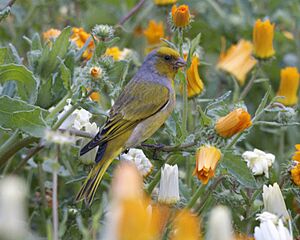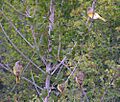Cape canary facts for kids
Quick facts for kids Cape canary |
|
|---|---|
 |
|
| Conservation status | |
| Scientific classification | |
| Genus: |
Serinus
|
| Species: |
canicollis
|
| Subspecies | |
|
3, see text |
|
The Cape canary (Serinus canicollis) is a small songbird that belongs to the finch family. These birds live all year round in southern Africa. They have also been brought to the islands of Mauritius and Réunion.
Contents
Where Cape Canaries Live
Cape canaries like to live in natural areas with special plants called fynbos. They also enjoy grasslands and gardens, especially in higher, mountainous places. These clever birds build a neat, cup-shaped nest hidden in bushes.
What Cape Canaries Look Like
Cape canaries are small birds, about 11 to 13 centimeters long. That's about the length of your hand!
Male and Female Birds
- Male Cape Canaries: They have a green back. Their wing and tail feathers have black edges. Their tummy, bottom, and sides of their tail are bright yellow. The lower part of their belly is white. The back of their head and neck are grey, and their face is a warm reddish-brown color.
- Female Cape Canaries: They look a lot like the males, but they have less grey on their head.
Young Cape Canaries
Young Cape canaries, called juveniles, have greenish-yellow tummies with lots of brown stripes.
How to Tell Them Apart from Other Birds
It's easy to spot a Cape canary because it doesn't have the black face markings that the yellow-fronted canary has.
What Cape Canaries Do and Sound Like
Cape canaries are very common birds. They often gather in groups and love to eat seeds. When they call out, it sounds like tsit-it-it. Their song is a beautiful mix of trills and whistles, a bit like a European goldfinch. They sing while flying or from a high spot like a branch.
Different Types of Cape Canaries
Just like there are different types of dogs, there are also different types, or "subspecies," of Cape canaries. These are slightly different versions of the same bird.
Here are some of the main subspecies:
- Cape canary (S. c. canicollis) (Swainson, 1838)
- S. c. griseitergum Clancey, 1967
- Kivu canary (S. c. sassii) Neumann, 1922
There's also a very special type of canary from East Africa (S. c. flavivertex). This one is much brighter and has a yellow head instead of grey. Scientists usually consider it a separate species now, called the yellow-crowned canary (S. flavivertex).
Gallery
-
A Cape Canary in South Africa
-
Four Cape Canaries in a tree, South Africa




